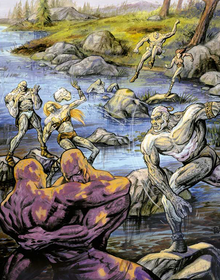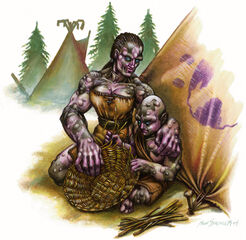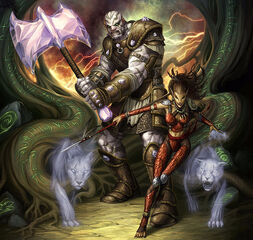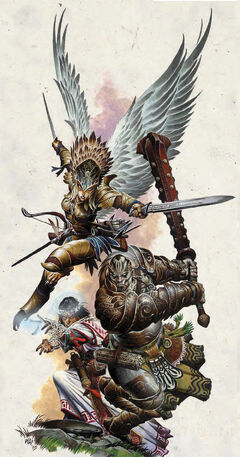Goliaths were a nomadic race of humanoids native to the mountainous regions of Toril.
Description
Goliaths were massive. They averaged between 7 and 8 feet meaning they even taller than dragonborn. Goliaths had noticeably bony or prominent supraorbital ridges above their eyes.[11]
Skin
Goliath skin was often gray or brown and was extremely tough (often compared to stone).[6] One of the most distinctive features of the goliath was the darker (often vertically symmetrical) patches of skin that covered their entire bodies.[11]
Goliath skin was littered with bony growths called lithoderms. These growths were roughly the size of a coin and appeared like studded pebbles on their arms, shoulders, torso or head.[11]
Personality
Goliaths most notable characteristic was their competitiveness. They kept track of their accomplishments and saw everything as a challenge. Those not familiar with goliath psychology would often get annoyed when goliaths constantly reminded them how many times a certain thing had happened, thinking them arrogant or self-centred. This was not the case however. To goliaths, score-keeping was a natural and integral part of life, not meant to belittle or demean anyone.[5]
A goliath's most fierce competitor was themselves. Beating their own records was the most satisfying victory for a goliath. They were also competitive with their companions and other goliaths, but were never arrogant or cocky.[11]
Goliaths had little time for cheaters, gloaters and sore losers.[11] Goliaths never held grudges if they lost a fair fight, and would often repeat the goliath maxim that "Today’s rival is tomorrow’s teammate."[12]
Their constant comparison to their past accomplishments could be hard on goliaths that fail to meet goals or measure up to achievements of the past.[11] Goliaths would often feel dissatisfied with anything that didn't surpass a victory from their past. This unfortunate element of goliath psychology led many older goliaths to be very unhappy with themselves when they could no longer perform as well as they could in their youth.[12]
It was rare for goliath adventurers to retire or live to an old age, as they often died trying to surpass their previous achievements. Permanently injured or ageing goliaths often seek death in battle rather than succumb to an existence where they cannot excel.[13]
Trust and honor were key aspects of most goliaths.[11] This tradition of honor and trust mean that Goliaths tended to be good overall. This combined with their competitive nature often led goliaths to valorous heroics.[14] Goliaths were also notably daring and fearless. Feats of physical strength and agility, like jumping chasms or climbing cliffs, held no fear for goliaths.[11] Goliaths were naturally curious beings and loved to explore.[7]
Complacency was a trait that goliaths loathed and as a result they never took anything for granted. Even goliaths with magical advantages would continue to train their physical prowess in case they ever lost their power.[13]
Combat
Goliath tribes only went to war as a final option, preferring to move away from unsafe lands. They did not do this out of fear or cowardice, instead they were aware that loss of life in their tribe was undesirable and had long term consequences.[15]
If forced to go to war however, a tribe would do so without fear. Circumstances that might force a tribe included; being cornered or having members of their tribe kidnapped. Once weapons are distributed and war-captains were chosen a goliath tribe could quickly become a very capable war-band. Goliaths were always at the peak of their physical condition and their fine tuned hunting skills made them competent warriors at a moment's notice.[15]
All adult goliaths (regardless of gender) fought in times of war. Only children and infants were expected not to fight.[15]
hide and leather armor was favoured by goliaths as they already had naturally durable bodies and did not like to restrict their movement. Goliaths often used large two handed weapons to make the most of their considerable strength.[15]
Goliaths often employed guerilla tactics in battle, due to their upbringing as hunters. Fair-play was also integral to goliath fights. As long as they were fairly sure they can still win, goliaths would handicap themselves to give their opponents a fair chance, e.g. If a goliath disarmed their opponent, they would throw aside their own weapon and continue the fight with their fists.[15]
As with their recreational sports, goliaths seriously frowned upon "cheating" in battle. Finishing off a fallen foe, taking hostages, and attacking civilians were considered distasteful and unfair.[15]
Society
Goliath society's key focus was competitiveness.[15] Their society also held equality and fairness in high regard.[13]
Tribes
Goliaths lived in small tribes that numbered between forty and sixty goliaths. This was usually made up of three to five extended families. Most goliaths lived in the same tribe their entire life. On rare occasions a tribe that got too large would split into smaller tribes or smaller tribes would merge together.[16]
Goliath tribes had a number of key roles that were filled by the most capable members. Summaries of these roles are included below;
- Chieftain: The primary authority figure in a tribe. The chieftain was responsible for choosing when the tribe should move on to new lands. The chieftain also chose who filled some of the other key roles in the tribe.[16]
- Captian: Two captains were assigned to each of the important jobs each morning. These jobs included hunting, gathering, cooking and scouting. The captains then built their own teams and set out to achieve their task. Two captains were assigned to each task to encourage healthy rivalry.[17]
- Skywatcher: Often the most experienced druid or shaman of the tribe. Skywatchers made sure that resources were not over harvested and game animals weren't needlessly slaughtered. Skywatchers were often exempt from the teams that the captains assembled each morning. Skywatchers also oversaw festivals, rituals and celebrations.[17]
- Dawncaller: Responsible for guarding the camp overnight and alerting the tribe if there is trouble. At dawn they sung or bellowed tales of goliath bravery or heroics to wake everyone up. Dawncallers were assigned daily and given less work throughout the day so they could rest and be alert at night.[17]
- Adjudicator: Adjudicators settled disputes. Unless urgent an adjudicator would hear disputes after the evening meal. Tough decisions were often settled with a contest of the adjudicator's devising. If a goliath appealed against an adjudicator's decision, the chieftain had to settle the dispute, but would also have to dismiss the adjudicator from their position. Adjudicators also acted as referees for and sports. [17]
- Tent-mother:The only gender-specific role in the tribe because one of the her jobs was to be a wet-nurse. Chosen by the chieftain each morning, the tent-mother was responsible for care and teaching of the tribe’s infants and toddlers, as their parents were often busy with other responsibilities. It was also tent-mothers who decided when young goliaths were old enough to start contributing to the tribe (usually around the age of 10).[17]
- Lamentor: Responsible for determining when a member of the tribe was too old or weak to serve as a productive member of the tribe. Good lamentors would then approach the individual to explain their decision and consult the chieftain. Once it had been decided, the lamentor prepared a long chant to commemorate the goliath before the tribe exiled the old or weak individual form the tribe.[18]
Tribe chieftans only maintained power as long as they could prove they were suitable for that role. Due to this leadership constantly changed.[13] New leaders were chosen by contests. Any goliath could challenge the chieftain in an attempt to replace them. If this happened the chieftain and the challenger competed in three tasks. The challenger had to win all three to become the new chieftain. The old chieftain would then leave the tribe permanently.[18] Due to the fact that few goliaths lived to old-age, goliath tribes relied on innate wisdom in their leaders rather than wisdom gained form years of experience.[13]
The competitive nature of goliaths meant that the attitude and achievements of one would quickly inspire the whole tribe. Individuals within tribes would constantly be trying to outdo each other's good deeds. This meant that nearby settlements often stereotyped goliaths as a heroic and good people.[14]
Homelands
Goliath tribes were not large or permanent as the mountain terrain didnt allow for such settlements. Temporary villages would be set up then disassembled and relocated every month or so.[19]
Many of the goliath homelands were in the mountian ranges in northeast Faerûn. The Thesk Mountains, Mountains of Copper, Sunrise Mountains and Icerim Mountains were known to have goliath tribes.[7] The mountain ranges in and around Chult and Anauroch (notably Azirrhat) may also have been home to goliath populations.[8]
Goliaths were not afraid to mix with other cultures or travel. As of 1370 DR small numbers of goliath sellswords could be found as far away as the Sword Coast.[7]
Law and Justice
Although goliaths had no written laws or codes,[18] there were a number of unspoken rules that were commonly followed by most goliath tribes.
Because they were nomadic tribes who shared belongings or traded goods rather than use gold, conventional punishments like imprisonment or fining were not possible.[18] Instead tribes often employed the following punihsments;
- Beating: Goliaths caught stealing, cheating or disobeying the chieftain were beaten. Pain was considered a healthy motivator in goliath society.[18]
- Shunning: Shunning (known as volok-thea in Gol-Kaa) involved the tribe acting like the criminal didn't exist. They were not picked for teams or sports and were not provided with food and shelter. The length of the shunning was never spoken out right. Many goliaths claimed to "just know" how long a shunning should last.[18][20]
- Exile: The worst punishment a goliath could receive was exile. Before being exiled the chieftain assigned a new honorific middle name name to the goliath. Exile was also the fate of the old, weak or badly injured who couldn't contribute to the tribe. It should be noted that these individuals received a lament to commemorate their lives before their exile. Criminals received no such treatment.[20][13]
It was common for a goliath who knew they had failed their tribe to leave the tribe of their own accord, rather than force the tribe into the awkward position of exiling them. Some stubborn goliaths however had to be forced into exile.[20][21]
Culture
The cultures and traditions of goliath tribes varied from tribe to tribe and region to region but a number of traits were common across several tribes.[12]
Goliaths had little empathy or pity for adults who can't take care of themselves but they would treat and take care of the injured and sick. Permanently injured goliaths were still expected to contribute in every way that they could.[13]
Arts and crafting in goliath culture was limited by the resources they had to hand in the mountains. As a result goliaths were skilled in crafts like, flintknapping, tanning, stitching, creating simple pottery, bone-carving and painting.[15]
Goliath art was often colourful and expressive. Art was one of the few things that goliaths understood to be non-competive, they fully appreciated that art couldn't have a winner. Goliaths believed that art should be used to show people something they couldn't see in the real world. Goliaths decorated their tents, caves, weapons and clothes with abstract designs (often jagged, parallel lines and symbols that had astronomical significance).[22]
Language
The language of the goliaths was Gol-Kaa and it was spoken exclusivity for thousands of years. The language had only thirteen phonetic elements and was only ever spoken.[19]
Gol-Kaa was spoken in the active voice (“Kulagath climbed the mountain”) almost exclusively. It was grammatically torturous to use passive voice (“the mountain was climbed by Kulagath”).[23]
After interacting with dwarves and other races, the goliaths began to learn languages like dwarvish,[19] common[6] and giant[6]. Those tribes that learnt the written scripts of the dwarven language[note 1] began to transcribing their oral traditions and history into carvings, cave paintings and even books.[19] By 1491 DR many goliaths could speak, read and write in common and giant.[1]
Goliath names were made up of three parts; a first name assigned by the individual's parents, an honorific middle name chosen by the tribe's chief, and a family or clan name. The first name was often just one of two syllables. The honorific name assigned could change at the whim of the chief depending on particular achievements or failures. Exiled goliaths tended to carry middle names like "solitary" or "Kinless". The last name was often five or six syllables and always ended in a vowel.[19]
Religion
Most goliath tribes revered nature and the primal forces. Goliath shamans were known as "skywatchers"[11] or "sunspeakers"[2]. Despite this some goliaths did worship or honor gods.[11]
Leisure

Two teams of goliaths playing goat-ball.
Considering their competitive nature, its not surprising that sports were often played by goliaths to improve their physical skills and pass time. Simple games included climbing, sprinting and wrestling.[24]
Other games that were popular amongst many tribes included;
- Goat-ball: Involved the use of a stuffed goat hide which was tossed around by two teams (usually four a side). The two teams would jump around on several raised platforms (usually rocks or logs) trying to pass, intercept and hit each other with the goat-ball. Any participants that were hit by the goat-ball were out of the game. Participants who fell or were knocked from their platform were also out. One team lost once all their players were out.[22]
- Stubborn-root: One goliath was chosen to be the "root" and would have to defend a ridge or peak from the other competitors (similar to king of the mountain played by children in towns and cities).[12]
- Cliff-climb: Simple cliff climbing race. Most races involved climbing up a cliff and then climbing back down. Participants could choose to fall part of the way on the return climb to save time, but risked injuring themselves. The winner was often the best of three races. Particularly skilled climbers would often handicap themselves by wearing backpacks full of stones.[12]
Interracial Relations
Goliaths were friendly to anyone who didn't threaten their tribe, but wouldn't wait around for travellers who couldnt keep up with them.[10]
Goliaths were particularly fond of dwarves and had great respect for dwarven blacksmiths. Some goliaths would even venture into mountain tunnels to seek out dwarves to trade with.[10]
Human rangers or druids were known to sometimes work together with goliath tribes in hunts. Both the humans and goliaths could mutually benefit from these temporary alliances.[10]
Goliaths often referred to earth genasi as their "cousins". The two races maintained a friendly rivalry.[8]
Elves were somewhat intimidating to goliaths due to their long lifespans. Goliaths often struggled with the idea that creatures existed that were old enough to have known their great-grandparents and ancestors.[19]
Although they have no particular hatred of goblins, orcs or half-orcs, goliaths are wary of them. This is mostly due to the stories that they heard from passing travellers about the trouble they caused.[19]
Attitudes towards giants varied. Some tribes traded with giants. Giant weapons were not as well crafted as dwarven ones, but they were a far more suitable size. Some giants however, would try and make goliaths into slaves. This led to conflicts and goliaths being wary of giants.[19]
Goliaths who ventured out of their tribes would often find issue with class divisions found in other societies. Goliaths struggled with the idea that an incompetent king could rule over hard-working peasants. These opinions were often shared and goliaths would openly mock incapable leaders or rich nobleman who relied on social structures to maintain their power.[13]
History
It's unclear how old the goliath race was or where they originally came from but it was commonly believed that they were somehow related to stone giants or earth genasi.[8]
By 1479 DR, many of the mountain dwelling goliath tribes had became even more isolated due to the spellscarred lowlands. The tribes stayed in the safety of their mountain tops and few travellers ventured across the dangerous lowlands.[7]
Notable Goliaths
- Mualio Lonehunter
- Mualio was one of the most famous goliaths to ever live. The legends surrounding Mualio were vast and extended way over the natural lifespan of a goliath. The name Mualio Lonehunter was secretly passed down over each generation enabling the legendary figure to continue protecting his people.[25]
Notable Locations
- Thella-Lu
- Thella-Lu was the cloest thing the goliaths had to a major city. Located in the Plain of Standing Stones in Anauroch, Thella-Lu was a sprawling mass of tents. At any one time, more than 100 tribes would be gathered at Thella-Lu to trade, socialize and compete in sports.[26]
Appendix
Further Reading
- David Noonan, Jesse Decker, Michelle Lyons (August 2004). Races of Stone. (Wizards of the Coast), pp. 53–84. ISBN 0-7869-3278-3.
Notes
- ↑ On page 55 of Races of Stone it states that goliaths learnt the "alphabet of the dwarven language". Races of Stone is not a realm-specific sourcebook but in the Forgotten Realms, the dwarven alphabet is known as dethek. With this in mind (and considering they live in close proximity to dwarves) we can infer that many goliaths write in dethek.
Appearances
- Christopher Rowe (March 2011). Sandstorm. (Wizards of the Coast). ISBN 978-0786957422.
- Erik Scott de Bie (March 2007). Depths of Madness. (Wizards of the Coast). ISBN 978-0-7869-4314-2.
Gallery
References
- ↑ 1.0 1.1 1.2 1.3 1.4 1.5 1.6 1.7 Template:Cite book/Elemental Evil Player's Companion
- ↑ 2.0 2.1 Rob Heinsoo, Stephen Schubert (May 19, 2009). Monster Manual 2 4th edition. (Wizards of the Coast), p. 136. ISBN 0786995101.
- ↑ Template:Cite book/Races of Stone/Raiders of the High Citadel
- ↑ David Noonan, Jesse Decker, Michelle Lyons (August 2004). Races of Stone. (Wizards of the Coast), p. 84. ISBN 0-7869-3278-3.
- ↑ 5.0 5.1 David Noonan, Jesse Decker, Michelle Lyons (August 2004). Races of Stone. (Wizards of the Coast), p. 56. ISBN 0-7869-3278-3.
- ↑ 6.0 6.1 6.2 6.3 6.4 Jeremy Crawford, Mike Mearls, James Wyatt (March 2009). Player's Handbook 2. (Wizards of the Coast), p. 12. ISBN 0-7869-5016-4.
- ↑ 7.0 7.1 7.2 7.3 7.4 Rob Heinsoo, Logan Bonner, Robert J. Schwalb (September 2008). Forgotten Realms Player's Guide. (Wizards of the Coast), p. 21. ISBN 978-0-7869-4929-8.
- ↑ 8.0 8.1 8.2 8.3 Thomas M. Reid, Sean K. Reynolds (Nov. 2005). Champions of Valor. (Wizards of the Coast), p. 17. ISBN 0-7869-3697-5.
- ↑ David Noonan, Jesse Decker, Michelle Lyons (August 2004). Races of Stone. (Wizards of the Coast), p. 72. ISBN 0-7869-3278-3.
- ↑ 10.0 10.1 10.2 10.3 10.4 David Noonan, Jesse Decker, Michelle Lyons (August 2004). Races of Stone. (Wizards of the Coast), p. 54. ISBN 0-7869-3278-3.
- ↑ 11.00 11.01 11.02 11.03 11.04 11.05 11.06 11.07 11.08 11.09 11.10 11.11 11.12 11.13 Jeremy Crawford, Mike Mearls, James Wyatt (March 2009). Player's Handbook 2. (Wizards of the Coast), p. 13. ISBN 0-7869-5016-4.
- ↑ 12.0 12.1 12.2 12.3 12.4 David Noonan, Jesse Decker, Michelle Lyons (August 2004). Races of Stone. (Wizards of the Coast), p. 57. ISBN 0-7869-3278-3.
- ↑ 13.0 13.1 13.2 13.3 13.4 13.5 13.6 13.7 Template:Cite book/Elemental Evil Player's Companion
- ↑ 14.0 14.1 Thomas M. Reid, Sean K. Reynolds (Nov. 2005). Champions of Valor. (Wizards of the Coast), p. 19. ISBN 0-7869-3697-5.
- ↑ 15.0 15.1 15.2 15.3 15.4 15.5 15.6 15.7 David Noonan, Jesse Decker, Michelle Lyons (August 2004). Races of Stone. (Wizards of the Coast), p. 60. ISBN 0-7869-3278-3.
- ↑ 16.0 16.1 David Noonan, Jesse Decker, Michelle Lyons (August 2004). Races of Stone. (Wizards of the Coast), p. 61. ISBN 0-7869-3278-3.
- ↑ 17.0 17.1 17.2 17.3 17.4 David Noonan, Jesse Decker, Michelle Lyons (August 2004). Races of Stone. (Wizards of the Coast), p. 62. ISBN 0-7869-3278-3.
- ↑ 18.0 18.1 18.2 18.3 18.4 18.5 David Noonan, Jesse Decker, Michelle Lyons (August 2004). Races of Stone. (Wizards of the Coast), p. 63. ISBN 0-7869-3278-3.
- ↑ 19.0 19.1 19.2 19.3 19.4 19.5 19.6 19.7 David Noonan, Jesse Decker, Michelle Lyons (August 2004). Races of Stone. (Wizards of the Coast), p. 55. ISBN 0-7869-3278-3.
- ↑ 20.0 20.1 20.2 David Noonan, Jesse Decker, Michelle Lyons (August 2004). Races of Stone. (Wizards of the Coast), p. 64. ISBN 0-7869-3278-3.
- ↑ David Noonan, Jesse Decker, Michelle Lyons (August 2004). Races of Stone. (Wizards of the Coast), p. 65. ISBN 0-7869-3278-3.
- ↑ 22.0 22.1 David Noonan, Jesse Decker, Michelle Lyons (August 2004). Races of Stone. (Wizards of the Coast), p. 59. ISBN 0-7869-3278-3.
- ↑ David Noonan, Jesse Decker, Michelle Lyons (August 2004). Races of Stone. (Wizards of the Coast), p. 72. ISBN 0-7869-3278-3.
- ↑ David Noonan, Jesse Decker, Michelle Lyons (August 2004). Races of Stone. (Wizards of the Coast), p. 58. ISBN 0-7869-3278-3.
- ↑ David Noonan, Jesse Decker, Michelle Lyons (August 2004). Races of Stone. (Wizards of the Coast), pp. 69–70. ISBN 0-7869-3278-3.
- ↑ David Noonan, Jesse Decker, Michelle Lyons (August 2004). Races of Stone. (Wizards of the Coast), pp. 90–82. ISBN 0-7869-3278-3.




